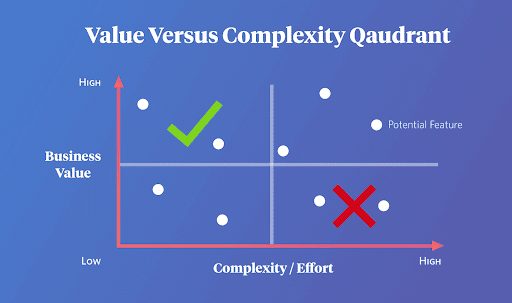Optimizing your customer feedback strategy

Last updated on January 23, 2024
Your customers are sharing their experiences online. They’ve been doing it for years, but with the continuing proliferation of social media platforms, their voices are only getting louder. No matter what industry you’re in, your customers are eager and encouraged to share their feedback: the good, the bad, and the ugly.
Businesses that want to grow this year (and beyond) realize that this isn’t a problem—it’s an opportunity.
Your customers are a wealth of information on how you can improve your marketing, sales, and customer experience. All you have to do is ask (and listen!). You’ll be richly rewarded: 78% of customers have a more favorable view of brands that ask for feedback.
Strategically reacting to customer feedback can increase customer loyalty and retention. It’s the surest way to build a better product. But the path to doing so isn’t always clear.
In this post, you’ll learn why customer feedback is integral to your business’s success. We’ll explain how to create a customer feedback strategy that collects customer feedback and creates a smart action plan that drives business results.
In This Article:
Frame your customer feedback collection around your customer journey
Every customer’s experience is unique. But when you zoom out and think about your customers’ experiences as a whole, you’ll see some common elements: the channels they use to purchase your products, the ways they contact your support team, and the systems they interact with.
These commonalities are elements of your customer journey—the sum of all interactions customers have with your brand. As you craft your customer feedback strategy, you need to make sure the feedback you receive reflects each stage of the customer journey. Many businesses fall into the trap of only thinking about specific customer touchpoints—like contacting your support team—but isolating any touchpoint from the overall customer journey is dangerous:
- You can improve your support touchpoints, but what if your onboarding experience is awful?
- Or, you can improve your onboarding experience, but if your marketing copy makes false claims about what your product can do, you’re in trouble.
As Scott Tran, founder of Support Driven, says, “How can you make good decisions for the customer without listening to customers? You need to listen to the good, the bad, and the ugly feedback to make good decisions.”
Collecting feedback across the entire customer journey shows you which areas your business needs to focus on. It helps you prioritize. The most common method companies use to collect feedback at scale are surveys, including:
- Customer Satisfaction surveys (CSAT)
- Net Promoter Score surveys (NPS)
- Customer Effort Score surveys (CES)
Deploying surveys is a foundational part of gathering customer feedback. However, a robust Voice of the Customer program also uses things like customer conversations, social media, and website behavior as inputs. Each of these should be incorporated into your customer feedback strategy.
Here’s an example of what gathering customer feedback might look like across a few common stages of the customer journey:
- Awareness Stage: Prospective customers will have plenty of questions about your products. As they interact with your website, your sales team, or tools like a chatbot, you can capture their questions and concerns to improve your marketing and sales efforts. This is a great way to drive additional revenue growth over time.
- Retention Stage: 89% of companies with “significantly above average” customer experiences perform better financially than their competitors. Acting on the feedback you receive and improving your customers’ experience can give you an edge over your competitors.
You might gather this feedback through a post-support case CSAT survey or a post-onboarding CES survey. Asking open-ended questions as part of your surveys captures a wealth of feedback you can use to improve your customer experience. - Advocacy Stage: Happy customers are a powerful source of growth. That’s why Net Promoter Score is such a popular metric. Once a customer is established and seeing results, measuring and improving your NPS will drive future growth via referrals.

NPS surveys are one common component of a solid customer feedback strategy
Create a plan to act on the feedback you receive
When your feedback collection strategy is working well, your customers may be providing overwhelming amounts of feedback. It can almost feel paralyzing. Fortunately, survey analytics makes it relatively straightforward to turn customer data into actionable insights.
The main thing to remember is this: customer feedback is worthless if it isn’t generating meaningful change in your business. It’s only through consistently actioning feedback that you’ll see measurable business results.
There are four critical steps that your customer feedback strategy should include if you want it to drive business success:
- Organize your customer feedback
- Prioritize actionable insights
- Communicate customer feedback across your company
- Close the loop with customers
Customer feedback isn’t always clear or easy to implement, but committing to this strategy for a sustained period of time will bring positive results for your business.
Organize your customer feedback
The more organized your method of collecting feedback is, the easier it will be to put it into action.
Unfortunately, many companies encounter one of two barriers when it comes to organizing customer feedback: data silos and manual workloads.
Data silos occur because it’s common for companies to capture customer feedback using a wide variety of tools. When you have data living in a dozen different tools, it’s incredibly difficult to extract valuable insights from it. You’ll never feel like you’ve got a full picture of your customer experience.
The second barrier to organizing actionable customer feedback is the level of manual effort involved. In many cases, customer insights teams are forced to dump data into Excel or Google Sheets and manually read and tag each piece of feedback. This eats up hours and hours of work, making it very time-consuming to generate meaningful insights.
The most effective way to avoid both of these barriers is to leverage an intelligent customer experience platform like Lumoa. A modern CX tool enables you to easily connect disparate data sources, eliminating data silos for good. It also enables real-time insights into key CX metrics, reducing manual effort and the time it takes to uncover relevant insights.
Prioritize actionable insights
Once you’ve organized your customer feedback and generated insights, you’re ready to prioritize your response.
The right customer feedback analysis tool can also make this easy by identifying the chief drivers impacting your CX metrics. Understanding these drivers—the items that are having the biggest impact on your NPS, CSAT, and so on—enables you to spend less time on analysis and more time on improving your product and customer experience.
If your current CX tool stack doesn’t make this easy, try using a feedback prioritization matrix to determine where you should take action. A prioritization matrix scores the possible actions you should take based on two criteria:
- The potential value for your business
- The complexity or level of effort involved

Your customer feedback strategy should prioritize items that are high-value and relatively low effort
Source
Each potential project’s place on the matrix shapes your decision to move forward. Since your business (and every business) has limited resources, you have to make choices about how to spend your time and money.
For example, perhaps your customer feedback shows a strong customer appetite for an improvement to your email marketing tools. There’s an equally strong appetite for a brand new reporting feature.
How do you decide which projects to work on?
If the new feature requires more effort (because it’s a brand new development) and delivers less value (because your core product is your email marketing capability), then it becomes far easier to deprioritize that initiative.
While a feedback prioritization matrix doesn’t identify the key drivers of your customer experience in quite the same way as a great CX tool does, it’s still a powerful part of your customer feedback strategy.
Communicate customer feedback across your company
Customer feedback is most impactful when it’s easily accessible to individuals across your organization.
Your CX platform may allow you to add users from your company or to create dashboards that your whole company can access. If that’s the case, these features can be immensely useful in creating a customer-centric company culture.
If you don’t have the ability to easily do this right now, then your customer feedback strategy should include thoughtful ways to share valuable customer insights with the teams who need them. Each team’s priorities will differ, meaning you’ll need to communicate differently with each one:
- Your marketing team will want to understand when customers experience a disconnect between your messaging and your products, but they won’t care so much about software bugs.
- Your customer success team will need to understand the sentiment and concerns of specific customers, but they won’t be as interested in learning about how easy your customers think it is to use your help center.
- Your engineering and product teams will want both qualitative and quantitative data showing how many customers requested a new feature and what problem they’d be trying to solve with that feature.
There are plenty more examples, but the point is clear: tailoring your communication of customer insights is a critical part of your customer feedback strategy.
Close the loop with your customers
It may seem simple, but an often overlooked step in a customer feedback strategy is closing the loop with customers. This can be as simple as thanking them for providing feedback, but it’s far more impactful if you’re able to let customers know when you’ve acted in response to their feedback. This small step is deceptively powerful because a full 83% of customers feel more loyal to companies that respond to and resolve their concerns.
Take action on your customer feedback strategy
In today’s subscription-oriented economy, it’s more critical than ever for businesses to view their relationships with customers as long-term partnerships. If you can’t retain a customer’s business for the long haul, you’re wasting money on customer acquisition and you’re constantly battling high churn rates.
Think about it from your customers’ viewpoint: Why would you ask for their thoughts if you didn’t care?
Unfortunately, many businesses don’t do the work to understand and respond to customer feedback. This often leads to customers getting frustrated and dejected, but it also creates a huge opportunity: when you actually act on your customers’ feedback, they’re going to take notice.
That’s why a sound customer feedback strategy is mission-critical for businesses this year. The marketplace is more competitive than ever, and the companies that can stand out and deliver long-term success for their customers are the ones who will win.
If you’re ready to turbocharge your customer feedback strategy, investing in the right tool is the best way to get started. Kick off a free trial of Lumoa today to see how quickly investing in CX can bring measurable results for your business.
